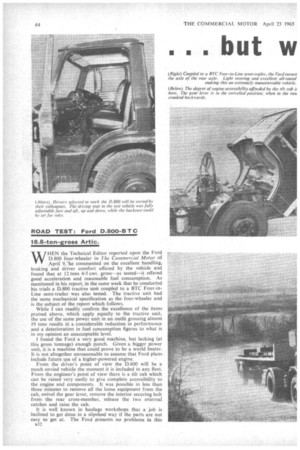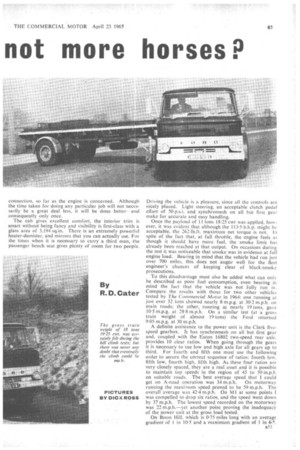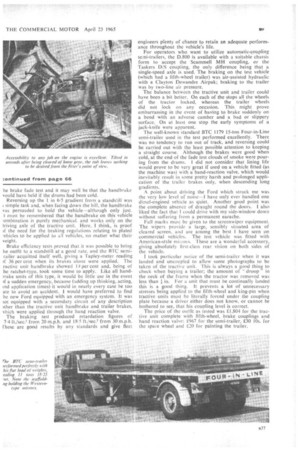. . but w not more horses
Page 66

Page 67

Page 68

Page 71

If you've noticed an error in this article please click here to report it so we can fix it.
By R. D. Cater
ROAD TEST; Ford D.800-B T C 18.8-ton-gross Artic.
WHEN the Technical Editor reported upon the Ford D.800 four-wheeler in The Commercial' Motor of April 9,-he commented on the excellent handling, braking and driver comfort offered by the vehicle and found that at 12 tons 6.5 cwt. gross—as tested—it offered good acceleration and reasonable fuel consumption. As mentioned in his report, in the same week that he conducted his trials a D.800 tractive unit coupled to a BTC Four-inLine semi-trailer was also tested. The tractive unit had the same mechanical specification as the four-wheeler and is the subject of the -report which follows.
While I can readily confirm the excellence of the items praised above, which apply equally• to the tractive unit, the use of the same power unit in an outfit grossing almost 19 tons results in a considerable reduction in performance and a deterioration in fuel consumption figures to what is in my opinion an unacceptable level.
I found the Ford a very good machine, but lacking (at this gross tonnage) enough punch. Given a bigger power unit, it is a machine that could prove to be a world beater. It is not altogether unreasonable to assume that Ford plans include future use of a higher-powered engine.
From the driver's point of view the D.800 will be a much envied vehicle the moment it is included in any fleet. From the engineer's point of view there is a tilt cab which can be raised very easily to give complete accessibility to the engine and components. It was possible in less than three minutes to remove all the loose equipment from the cab, swivel the gear lever, remove the interior securing bolt from the rear cross-member, release the two external catches and raise the cab.
It is well known in haulage workshops that a job is inclined to get done in a slipshod way if the parts are not easy to get at. The Ford presents no problems in this
B32 connection. so far as the engine is concerned. Although the time taken for doing any particular job will not necessarily be a great deal less, it will be done better and consequently only once.
The cab gives excellent comfort, the interior trim is smart without being fancy and visibility is first-class with a glass area of 3,194 sq.in. There is an extremely powerful heater-demister, and mirrors that you can actually use. For the times when it is necessary to carry a third man, the passenger bench seat gives plenty of room for two people. Driving the vehicle is a pleasure, since all the controls are nicely placed. Light steering, an acceptable clutch pedal elfort of 50 p.s.i, and synchromesh on all but first gear make for accurate and easy handling.
Once the payload of 11 tons 18.25 cwt was applied, however, it was evident that although the 113-5 b.h.p. might be acceptable, the 262 lb.ft. maximum net torque is not. In spite of the fact that, at full throttle, the engine feels as though it should have more fuel, the smoke limit has already been reached at that output. On occasions during the test it was noticeable that smoke was in evidence at full engine load. Bearing in mind that the vehicle had run just over 700 miles, this does not augnr well for the fleet engineer's chances of keeping clear of black-smoke prosecutions.
To this disadvantage must also be added what can only be described as poor fuel consumption, even bearing in mind the fact that the vehicle was not fully run in. Compare the results with those for two other vehicles tested by The Commercial Motor in 1964: one running at just over 32 tons showed nearly 8 m.p.g. at 30-2 m.p.h. on main roads; the other, running at nearly 19 tons, gave 10-5 m.p.g. at 28-8 m.p.h. On a similar test (at a gross train weight of almost 19 tons) the Ford returned 9.05 m.p.g. at 30 m.p.h.
A definite assistance to the power unit is the Clark five
speed gearbox. It has synchromesh on all but first gear and, coupled with the Eaton 16802 two-speed rear axle. provides 10 clear ratios. When going through the gears it is necessary to use low and high axle for all gears up to third. For fourth and fifth one must use the following order to secure the correct sequence of ratios: fourth low, fifth low, fourth high, fifth high. As these four ratios are very closely spaced, they are a real asset and it is possible to maintain top speeds in the region of 45 to 50m.p.h. on suitable roads. The best average speed that I could
get on A-road operation was 34 m.p.h. On motorway running the maximum speed proved to be 59 m.p.h. The overall average was 42-4 m.p.h. On MI at some points 1 was compelled to drop six ratios, and the speed Went down by 37 m.p.h. The lowest speed recorded on the motorway was 22 m.p.h.—yet another point proving the inadequacy of the power unit at the gross load tested.
On Bison Hill. which is 0.75 miles long with an average gradient of 1 in 10-5 and a maximum gradient of 1 in 6,5, a33
a climb was made in 6 minutes 34 seconds. The lowest gear used (first-low) was engaged for a period of 3 minutes 14-6 seconds. As the cooling system was fitted with a header tank it was impossible to take accurate coolant temperature readings, btu, according to the panel-mounted gauge, there was no appreciable rise. .
The brake fade test was carried out by coasting down Bison at 20 m.p.h. against the brakes and, when the speed dropped below 20 m.p.h., engaging top-low gear and driving against the brakes. This brought the whole system in for some severe punishment. Even so. a full-pressure stop at the bottom of the hill from 20 m.p.h. produced a Tapley-04
,meter reading of 63 per cent—a drop of only seven per cent over the same test with the brakes cold, Stop and start tests on Bison proved that the vehicle would not move off up the hill in high-first gear; but in low-first it was a simple proposition, needing only slight clutch-slip to get it moving. These tests also proved that the handbrake would not hold the vehicle no matter how strongly it was applied: even when applied with the assistance of the footbrake, it was still not powerful enough. It is true to say, however, that this test was carried out after he brake fade test and it may well be that the handbrake vould have held if the drums had been cold.
Reversing up the 1 in 6-5 gradient from a standstill was i simple task and, when facing down the hill, the handbrake vas persuaded to hold the vehicle—although only just. t must be remembered that the handbrake on this vehicle :ombination is purely mechanical, and works only on the Hying axle of the tractive unit. Here, I think, is proof if the need for the braking regulations relating to plated Thicles to be applied to all vehicles, no matter what their veight.
Brake efficiency tests proved that it was possible to bring he outfit to a standstill at a good rate, and the BTC semirailer acquitted itself well, giving a Tapley-meter reading if 36 per cent when its brakes alone were applied. The ractive unit handbrake showed 19 per cent and, being of he ratchet-type, took some time to apply. Like all handmake units of this type, it would be little use in the event if a sudden emergency, because (adding up thinking, acting, Ind application times) it would in nearly every case be too ate to avoid an accident. I would have preferred to find he new Ford equipped with an emergency system. It was lot equipped with a secondary circuit of any description sther than the tractive unit handbrake and trailer brakes, vhich were applied through the hand reaction valve.
The braking test produced retardation figures of 7.4 telsec." from 20 m.p.h. and 18.5 ft./sec.' from 30 m.p.h. ['hese are good results by any standards and give fleet
engineers plenty of chance to retain an adequate performance throughout the vehicle's fife.
For operators who want to utilize automatic-coupling semi-trailers, the D.800 is available with a suitable chassis form to accept the Scammell MH coupling, or the Taskers D/S coupling, the only difference being that a single-speed axle is used. The braking on the test vehicle (which had a fifth-wheel trailer) was air-assisted hydraulic with a Clayton Dewandre Airpak; braking to the trailer was by two-line air pressure.
The balance between the tractive unit and trailer could have been a bit better. On each of the stops all the wheels of the tractor locked, whereas the trailer wheels did not lock on any occasion. This might prove embarrassing in the event of having to brake suddenly on a bend with an adverse camber and a bad or slippery surface. On at least one stop the early symptoms of a jack-knife were apparent.
The well-known standard EITC 1179 15-ton Four-in-Line semi-trailer used in the test performed excellently. There was no tendency to run out of track, and reversing could be carried out with the least possible attention to keeping a straight course. Although the brakes were good when cold, at the end of the fade test clouds of smoke were pouring from the drums. 1 did not consider that lining life would prove to be very great if used on a vehicle fitted (as the machine was) with a hand-reaction valve, which would inevitably result in some pretty harsh and prolonged application of the trailer brakes only, when descending long gradients.
A point about driving the Ford which struck me was the very low level of noise-1 have only ever handled one diesel-engined vehicle as quiet. Another good point was the complete absence of draught round the doors. I also liked the fact that I could drive with my side-window down without suffering from a permanent earache.
Full marks must be given to the screenwiper equipment. The wipers provide a large, sensibly situated area of cleared screen, and are among the best I have seen on commercial vehicles. The test vehicle was fitted with American-style mirrors. These are a wonderful accessory, giving absolutely First-class rear vision on both sides of the vehicle.
I took particular notice of the semi-trailer when it was landed and uncoupled to allow some photographs to be taken of the tractive unit. This is always a good thing to check when buying a trailer; the amount of "droop " in the neck of the frame when the tractor was removed was less than in. For a unit that must be continually landed this is a good thing. It prevents a lot of unnecessary stresses being applied to the fifth-wheel and king-pin when tractive units must be literally forced under the coupling plate because a driver either does not know, or cannot be bothered to see, that his coupling level is correct.
The price of the outfit as tested was £1,804 for the tractive unit complete with fifth-wheel, brake couplings and hand reaction valve: €967 for the semi-trailer, £30 10s. for the spare wheel and £20 for painting the trailer.




































































































































